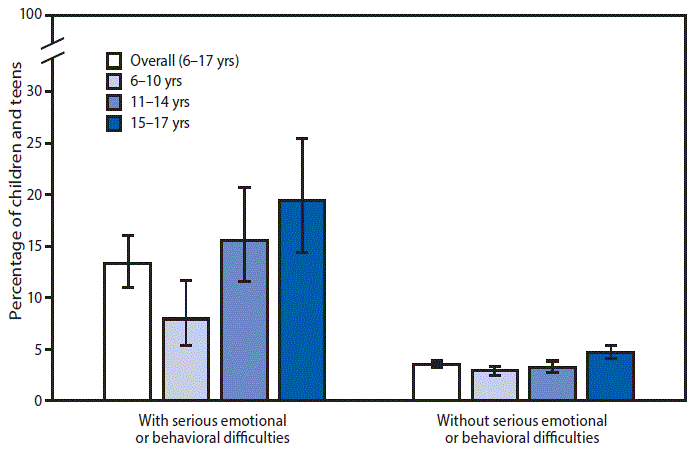QuickStats: Percentage* of Children and Teens Aged 6–17 Years Who Missed >10 Days of School in the Past 12 Months Because of Illness or Injury,† by Serious Emotional or Behavioral Difficulties Status§ and Age Group — National Health Interview Survey, 2014–2016¶
Weekly / November 10, 2017 / 66(44);1239

* With 95% confidence intervals indicated by error bars.
† Number of missed school days was based on the following question: “During the past 12 months about how many days did (child) miss school because of illness or injury?” Children who did not attend school were excluded.
§ Serious emotional or behavioral difficulties (EBDs) were based on parents’ responses to the following question: “Overall, do you think that (child) has any difficulties in one or more of the following areas: emotions, concentration, behavior, or being able to get along with other people?” Children whose parent or guardian responded “yes, definite” or “yes, severe” were defined as having serious emotional or behavioral difficulties. These difficulties might be similar to but do not equate with the federal definition of serious emotional disturbance. For 2014–2016 the prevalence of serious EBDs among children aged 6–17 years was 5.8%.
¶ Estimates are based on household interviews of a sample of the noninstitutionalized U.S. civilian population and are derived from the National Health Interview Survey Sample Child component.
During 2014–2016, children aged 6–17 years whose parent or guardian indicated the child had serious emotional or behavioral difficulties (EBDs) were almost four times as likely to miss >10 days of school because of illness or injury compared with children without serious EBDs (13.4% compared with 3.5%). Among children with serious EBDs, those aged 6–10 years were less likely (8.0%) to miss >10 days of school compared with children aged 11–14 years (15.6%) and children aged 15–17 years (19.5%). Among children without serious EBDs those aged 15–17 years (4.7%) were more likely to miss >10 school days compared with children aged 6–10 years (3.0%) and children aged 11–14 years (3.3%).
Source: National Center for Health Statistics. National Health Interview Survey, 2014–2016. https://www.cdc.gov/nchs/nhis.htm.
Reported by: Cynthia Reuben, MA, car4@cdc.gov, 301-458-4458.























.png)











No hay comentarios:
Publicar un comentario